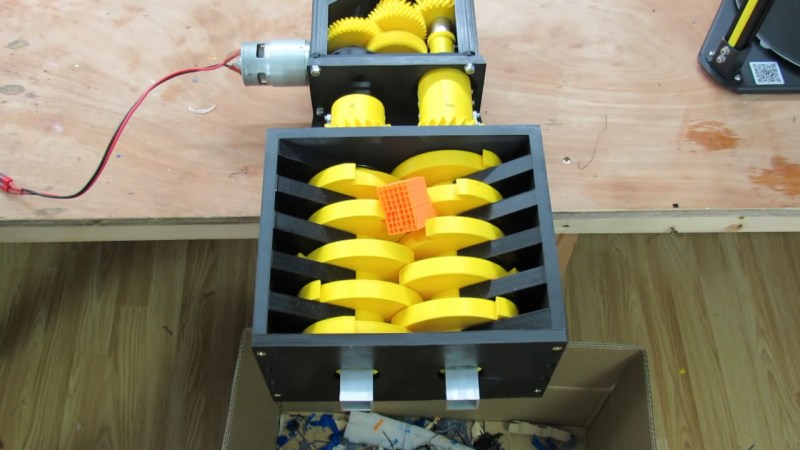[Brian Brocken] is at it again, building mechanisms that are as striking in their aesthetic as they are in their function. This time around, he’s extended a project we recently featured by adding a menacing 3D-printed shredder attachment. When you hear “3D-printed shredder” you think that paper is all you’ll be able to feed it, but this beast can eat its own by shredding parts from failed prints.
His original goal in building the high-torque 3D-printed gear box we looked at back in August was to show that 3D printed parts can be functional and not merely decorative. Using it as a winch to pull a car did a good job of that, but this goes much further. The very nature of shredder blades is to tear apart objects, but the forces that destroy those things are also present on the shredder parts themselves. Still, as you can see in the video below, the counter-rotating twin-shaft shredder mechanism does its work without catastrophic damage to the blades which were printed with “least 25 percent infill for the structural parts”, and up to five outer perimeters.
The result is a shredder that can gobble up small pieces of failed prints, in addition to chewing on paper, cardboard, and polystyrene with ease. [Brian] does show a few failures along the way, all in the gearbox itself. The first was a defect in the housing that let an gear shaft pop loose and was fixed up with a reprint. The second is a catastrophic gear failure when trying to shred a soda bottle. This is not surprising as PET is quite tough and not brittle like the waste prints were. The shredder teeth got bogged down, and the power of the motor strips teeth from a few gears. But when working, it’s oddly satisfying to watch that powerful gear ratio chip away at sacrificial materials.
If you’re more on the prowl for a way to usefully recycle your plastics, set the 3D-printed stress test of this one aside and take a look at the plastic shredder Fablab RUC built out of metal and plywood a few years back.















I don’t see the point in it with the current 3d printing technologies. It looks nice, but it is just isn’t there, and i don’t expect it to change. You can use smart ways to overcome *some* limitations, but you can’t all. 3d printing should be deprecated in favour of programmed materials.
What’s that ?
Something that isn’t realistic to expect any time soon. It’s like saying cars should be deprecated in favor of transporters.
https://en.wikipedia.org/wiki/Programmable_matter
The new season of Star Trek Discovery has this and it’s set 1000 years in the future. I wouldn’t be surprised if it took 1000 years before we see this become possible at any useful scale.
A billion tiny machines that join or release themselves in order to make things, like the liquid metal Terminator
Look for Isaac Arthur’s video on YouTube called Programmable matter. The kind of thing anyone can make/buy at Amazon nowdays… (Sarcasm alert)
I agree. Bicycles should also be deprecated in favour of spaceships.
Don’t forget food. Soylent green will be fine. No need for all that gourmet Vegetable stuff. Too inefficient.
I’m too lazy to buy bolts for the thing…
What is the point here, if the blades aren’t sharp ?
Have you seen the real, metal equivalents of this device?
They don’t have sharp blades. Because they simply do not need to be sharp, those things don’t cut, they crush.
Yes, but it works because metal is stronger than plastic so you don’t need to cut. Here, it’s plastic against plastic, so a little help might be required.
While there may be little point in this project – it’s the same amount of point that enthuses most of my projects. So I salute the shredder that can’t really shred.
Same. This thing’s an idea factory, and not trying to replace the metal version of these shredders.
I wonder how it would do if it were printed in wax then used as a mold for metal casting. Of course a commercial product would be made of steel and the metals that most of us might be able to work with in a home foundry are significantly softer than steel but they should still be better than plastic right?
It doesn’t have to be wax; it just has to have a melting point well below your metal’s, like PLA: https://all3dp.com/2/lost-pla-casting-guide/
You could use lost pla casting, so no need for wax and then you could case-harden those blades, it’s doable in backyard forge.
Nothing at all wrong with exploring the boundaries of materials, all useful, but hope he doesn’t accidentally explore how it copes with soft biological material!
No worries, I’m confident bone will stop it.
I agree. He should eat a chicken in there to test it lol
I remember printing this one years ago. Never assembled it since I didn’t have the bearings :) still have it in a box though printed.
https://www.thingiverse.com/thing:356580
Very similar design
I have a bunch of smallish D2 tool steel slugs laying around, I’ve been thinking about making the real deal with them. This is a bit of inspiration for the design.
Only problem is D2 is really nasty to machine…extremely wear resistant, so these were cut out with waterjet.
more like ‘will it squeeze between the gaps?’
That’s a strong little thing!